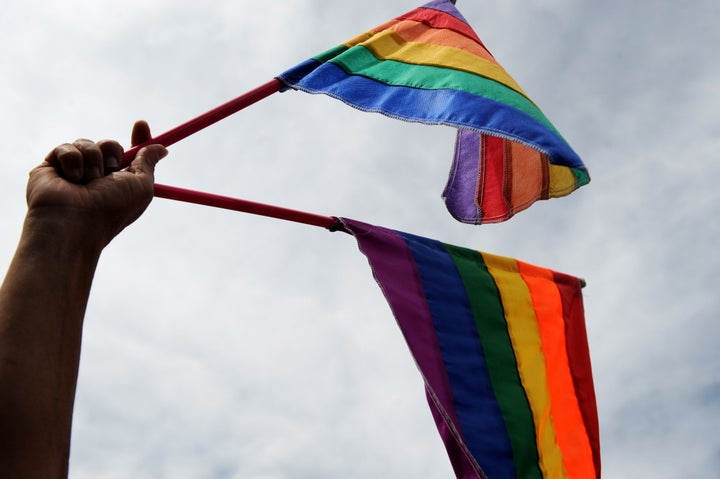
The polling company Gallup has waded into the debate regarding how many Americans are gay, lesbian, bisexual or transgender. It asked 121,290 individuals about their sexual orientation and gender identity, and, based on their answers, it came up with an estimate of 3.4 percent.
Gallup recognizes problems with its methodology, however:
As a group still subject to social stigma, many of those who identify as lesbian, gay, bisexual, or transgender may not be forthcoming about this identity when asked about it in a survey. Therefore, it's likely that some Americans in what is commonly referred to as "the closet" would not be included in the estimates derived from the Gallup interviews.
Gallup says it used a "broad measure of personal identification as LGBT" but admits that it actually excludes "sexual or other behavior, either past or present." In other words, individuals who consistently and regularly have same-sex relationships but who label themselves as heterosexual are not counted as members of the LGBT community.
The results of the poll indicate strongly that the estimate itself is clearly low. We have no reason to suspect that sexual orientation varies by race, age or income, but how one labels oneself does change from category to category. Gay religious fundamentalists are more likely to avoid labeling themselves as gay than are gay secular humanists, for example.
What we find in the Gallup survey is a pattern where some within the community are more willing to identify as LGBT than others. Non-Hispanic whites are less willing to identify as LGBT than are blacks, Hispanics or Asians. Whereas 4.6 percent of the black community identifies as LGBT, the percentage among non-Hispanic whites is just 3.2 percent.
Similarly, we see vast differences between age groups. Whereas 6.4 percent of people between the ages of 18 and 29 identify as LGBT, only 3.2 percent of those between the ages of 30 and 49 do so. We know younger gay people don't attach the same stigma to being gay that older ones do. Though there is a certain amount of fluidity in sexual identification, one's sexual attractions rarely shift substantially -- though one's behavior can change dramatically.
Even among the young, there are still plenty of individuals reluctant to identify as LGBT for numerous reasons, such as family or religious identification. It is unlikely that 100 percent of individuals who are LGBT will ever identify as such.
There are also differences according to income. Gallup reports:
Among those who report income, about 16% of LGBT-identified individuals have incomes above $90,000 per year, compared with 21% of the overall adult population. Additionally, 35% of those who identify as LGBT report incomes of less than $24,000 a year, significantly higher than the 24% for the population in general. These findings are consistent with research showing that LGBT people are at a higher risk of poverty.
There are some problems with this assertion. First, income correlates highly with age. Younger people, who are less wealthy in general, are more likely to identify as LGBT. That fact alone drives down the average for the LGBT community. In addition, women are far more likely to identify as LGBT than are men, and there is a lower income average for women in general. The "poverty" difference may not be measuring LGBT poverty at all but the relatively less-well-off status of younger people and women.
The survey also showed that LGBT women are as likely as others to be raising children. The presence of children in the home is more likely to raise poverty levels; more mouths to feed with the same income means more relative poverty. This is particularly true for single mothers, and if lesbian mothers are less likely to be partnered than straight mothers, it would raise the poverty average for all LGBT people.
Once we get beyond the basic results, we still don't know precisely how many people are gay, lesbian, bisexual or transgender. Results from younger people show that once we factor in people's reluctance to identify themselves, the percentage is probably above 5 percent. It seems reasonable to me to assume that the total number, while unknowable, is probably 5 to 10 percent of the population. Even with the low estimate, this is still 15.5 million Americans, and up to 31.1 million at the high estimate.
But should these numbers matter at all? Would marriage equality cease to matter if gays were 1 percent of the population?
Rights are not bestowed by group membership (though we often find people willing to deny rights to individuals because they are members of a group). That is what the concept of "individual rights" is all about. They belong to the individual. And, in the United States, it is supposed to be individual rights that undergird our legal system.
Thomas Jefferson would not have been keen on voters having the power to determine whether individuals or minorities have certain rights, as was the case with the infamous Proposition 8 in California. He wrote, "The majority, oppressing an individual, is guilty of a crime, abuses its strength, and by acting on the law of the strongest breaks up the foundations of society." He argued that "the rights of the whole can be no more than the sum of the rights of the individuals." That means that the best principle of the American republic is to "secure to all its citizens a perfect equality of rights." A perfect equality of rights can't be secured when gay and lesbian people are treated as second-class citizens, and not because of their individuality but because of an irrelevant collective trait.